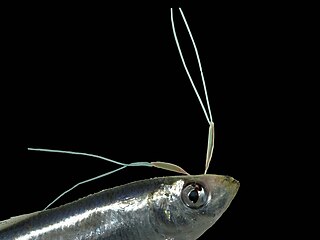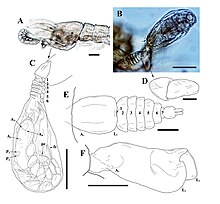
Copepods are a group of small crustaceans found in nearly every freshwater and saltwater habitat. Some species are planktonic, some are benthic, a number of species have parasitic phases, and some continental species may live in limnoterrestrial habitats and other wet terrestrial places, such as swamps, under leaf fall in wet forests, bogs, springs, ephemeral ponds, puddles, damp moss, or water-filled recesses of plants (phytotelmata) such as bromeliads and pitcher plants. Many live underground in marine and freshwater caves, sinkholes, or stream beds. Copepods are sometimes used as biodiversity indicators.

The family Argulidae, whose members are commonly known as carp lice or fish lice, are parasitic crustaceans in the class Ichthyostraca. It is the only family in the monotypic subclass Branchiura and the order Arguloida, although a second family, Dipteropeltidae, has been proposed. Although they are thought to be primitive forms, they have no fossil record.

The Cyclopoida are an order of small crustaceans from the subclass Copepoda. Like many other copepods, members of Cyclopoida are small, planktonic animals living both in the sea and in freshwater habitats. They are capable of rapid movement. Their larval development is metamorphic, and the embryos are carried in paired or single sacs attached to first abdominal somite.

Calanus is a genus of marine copepod in the family Calanidae. The genus was split in 1974, with some species being placed in a new genus, Neocalanus. The following species are recognised:

Poecilostomatoida is a suborder of copepods. Although it was previously considered a separate order, recent research showed it to be nested within the Cyclopoida.
Calamoecia is a genus of copepods in the family Centropagidae confined to Australasia. It is thought to have evolved since the separation of the Australian continent from Antarctica. Three of the Australian endemic species are listed as vulnerable species on the IUCN Red List. The genus contains the following species:
Muscocyclops is a genus of copepod crustaceans in the family Cyclopidae, comprising three species found only in South America. Two of the species – Muscocyclops bidentatus and Muscocyclops therasiae – are endemic to the Distrito Federal in Brazil, and are listed as conservation dependent on the IUCN Red List. The third species is Muscocyclops operculatus.
Tropocyclops is a genus of copepod crustaceans in the family Cyclopidae. It contains the following species:
Stygotantulus is a genus of crustacean with the sole species Stygotantulus stocki. It lives as an ectoparasite on harpacticoid copepods of the families Tisbidae and Canuellidae. It may be the smallest arthropod in the world, at a length of less than 0.1 millimetres (0.004 in). The specific name stocki commemorates Jan Hendrik Stock, a Dutch carcinologist.
Centropagidae is a family of copepods in the order Calanoida. Its members are particularly known as plankton in coastal waters and in fresh water in Australia and southern South America. They are also found on subantarctic islands and in lakes in Antarctica.

Crustaceans may pass through a number of larval and immature stages between hatching from their eggs and reaching their adult form. Each of the stages is separated by a moult, in which the hard exoskeleton is shed to allow the animal to grow. The larvae of crustaceans often bear little resemblance to the adult, and there are still cases where it is not known what larvae will grow into what adults. This is especially true of crustaceans which live as benthic adults, more-so than where the larvae are planktonic, and thereby easily caught.

Tegastidae is a family of copepods, which are characterised by having laterally compressed bodies, a claw-like mandible in the nauplius stage, and by a modified male genital complex. 85 species have been described in 6 genera. Two species of Smacigastes are found at hydrothermal vents, while the remaining species are found in shallow water, associated with algae, bryozoans and cnidarians, such as corals.

Copilia is a genus of copepods in the family Sapphirinidae. The eyes in members of this genus have two lenses, arranged like those in a telescope.

Lernaeocera branchialis, sometimes called cod worm, is a parasite of marine fish, found mainly in the North Atlantic. It is a marine copepod which starts life as a small pelagic crustacean larva. It is among the largest of copepods, ranging in size from 2 to 3 millimetres when it matures as a copepodid larva to more than 40 mm as a sessile adult.
Pennella is a genus of large copepods which are common parasites of large pelagic fishes. They begin their life cycle as a series of free-swimming planktonic larvae. The females metamorphose into a parasitic stage when they attach to a host and enter into its skin. The males are free swimming. Due to their large size and mesoparasitic life history there have been a number of studies of Pennella, the members of which are among the largest of the parasitic Copepoda. All species are found as adults buried into the flesh of marine bony fish, except for a single species, Pennella balaenopterae which can be found in the muscles and blubber of cetaceans and occasionally other marine mammals, and is the largest species of copepod.
Archidactylina is a genus of copepods that contains only the species Archidactylina myxinicola, and is the only genus in the family Archidactylinidae. It is a parasite of the gill pouches of two species of hagfish found in Japanese waters, Eptatretus okinoseanus and Myxine garmani.

The clade Multicrustacea constitutes the largest superclass of crustaceans, containing approximately four-fifths of all described crustacean species, including crabs, lobsters, crayfish, shrimp, krill, prawns, woodlice, barnacles, copepods, amphipods, mantis shrimp and others. The largest branch of multicrustacea is the class Malacostraca.

Hutchinsoniella macracantha is a species of crustacean known as a horseshoe shrimp. It is the only species in the genus Hutchinsoniella and was first described in 1955 by Howard L. Sanders, having been discovered in Long Island Sound; they were the first example of a new class of crustacean that was given the name Cephalocarida.

Lernaeenicus sprattae is a species of copepod in the family Pennellidae. It is a parasite of the European sprat and certain other fish and is sometimes known as the sprat eye-maggot.
Mesocyclops longisetus is a species of freshwater copepod in the family Cyclopidae. Two subspecies are accepted, Mesocyclops longisetus curvatus Dussart, 1987, and Mesocyclops longisetus longisetus. It has a neotropical distribution.












